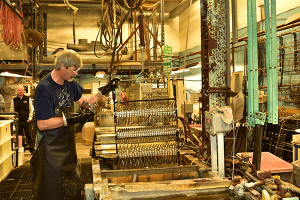Silver has been used for millennia in coins and ornamental objects, with silver plating emerging in the 18th century. As time progressed, a revolutionary technique called electroplating emerged in Italy during the early 19th century. This innovation quickly gained global acceptance and became the modern industrial standard for silver plating. Today, electroplating is the predominant method used in the industrial world to impart the lustrous beauty of silver onto a wide array of objects. But how does silver plating work? We break it down below.
What is Industrial Silver Plating?
The process of electroplating silver is relatively simple. Like most simpler processes, there are a few fundamental aspects integral to the electroplating of silver. Plating with silver should first consider the metal’s properties when considering where and how it’s used. The benefits of silver plating depend primarily on the application and the properties needed for it.
Industrial silver plating involves coating commoner metals like aluminum, copper, iron, lead, nickel, thallium, and zinc, also called base metals, with silver. Plating methods seek to achieve an even layer of silver to create a matte-white finish on an item’s surface. Silver plating is often applied to these metals to pass along the metal’s properties without using more significant amounts of the precious metal.
Industrial Silver Plating Process
Though all modern processes involve electrolysis, three standard silver plating techniques exist. The most common are barrel and rack plating, though another method known as reel-to-reel silver plating is sometimes also used. Barrel plating is commonly used on smaller components, resulting in a more uniform silver plating. For larger and more fragile workpieces, manufacturers tend to use the rack method of silver plating.
Barrel Silver Plating
The barrel process for silver plating entails using a cage shaped like a barrel made from non-conducting materials. This cage is submersed into a chemical solution within a tank, where the items to be plated slowly tumble. The individual items undergoing this silver plating procedure make contact with each other, which results in a more efficient process. Though this process results in silver plating that works well for most purposes, it neither produces an ornamental finish nor is it best to transfer silver’s valued properties to the item.
Rack Silver Plating
Workpieces with more complex geometries generally use the rack style of silver plating and those that are larger or more delicate. These racks can be specially built to accommodate both inside and outside diameters, and it’s an excellent technique for producing more selective plating buildup. This results in a more even distribution of silver plating components to augment conductivity, corrosion resistance, and solderability. With rack silver plating, components that are hung on the rack are submerged within a chemical solution, using bands or hooks to keep the parts in place. This also ensures the necessary electrolysis of the components; though it’s more labor-intensive than the barrel silver plating technique, it tends to cost more.
Reel-To-Reel Silver Plating
The reel-to-reel silver plating process works well for higher volume production, for which this method is both cost-effective and efficient. It involves wrapping a continuous rubber strip around components to cover the areas not to be plated. Automated reelers reel and de-reel components through the system, with quality control supported by high-tech vision equipment that allows silver plating of even the most delicate parts. However, changeovers and setups are time-consuming and complex, and plating arrangements have little flexibility.
Industrial Silver Plating by Silvex
Silvex Inc. specializes in plating with both platinum and silver. The plating capabilities of our company include coatings that are the thickness of a single micron to augment solderability, 10 microns to improve bonding, and as thick as 40 microns to offer significantly better wear resistance. Silvex can provide various specifications to companies regarding silver plating depending on the conductivity, hardness, purity, and solderability desired. We offer bright and matte silver-plating finishes for items up to four feet (1.22 m) long. They are made from aluminum, brass, copper, invar, kovar, steel, and titanium. To learn more about our silver plating and other services, contact Silvex today.

